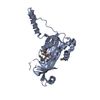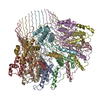+Search query
-Structure paper
| Title | Structural and mechanistic insights into the bacterial amyloid secretion channel CsgG. |
|---|---|
| Journal, issue, pages | Nature, Vol. 516, Issue 7530, Page 250-253, Year 2014 |
| Publish date | Dec 11, 2014 |
 Authors Authors | Parveen Goyal / Petya V Krasteva / Nani Van Gerven / Francesca Gubellini / Imke Van den Broeck / Anastassia Troupiotis-Tsaïlaki / Wim Jonckheere / Gérard Péhau-Arnaudet / Jerome S Pinkner / Matthew R Chapman / Scott J Hultgren / Stefan Howorka / Rémi Fronzes / Han Remaut /     |
| PubMed Abstract | Curli are functional amyloid fibres that constitute the major protein component of the extracellular matrix in pellicle biofilms formed by Bacteroidetes and Proteobacteria (predominantly of the α ...Curli are functional amyloid fibres that constitute the major protein component of the extracellular matrix in pellicle biofilms formed by Bacteroidetes and Proteobacteria (predominantly of the α and γ classes). They provide a fitness advantage in pathogenic strains and induce a strong pro-inflammatory response during bacteraemia. Curli formation requires a dedicated protein secretion machinery comprising the outer membrane lipoprotein CsgG and two soluble accessory proteins, CsgE and CsgF. Here we report the X-ray structure of Escherichia coli CsgG in a non-lipidated, soluble form as well as in its native membrane-extracted conformation. CsgG forms an oligomeric transport complex composed of nine anticodon-binding-domain-like units that give rise to a 36-stranded β-barrel that traverses the bilayer and is connected to a cage-like vestibule in the periplasm. The transmembrane and periplasmic domains are separated by a 0.9-nm channel constriction composed of three stacked concentric phenylalanine, asparagine and tyrosine rings that may guide the extended polypeptide substrate through the secretion pore. The specificity factor CsgE forms a nonameric adaptor that binds and closes off the periplasmic face of the secretion channel, creating a 24,000 Å(3) pre-constriction chamber. Our structural, functional and electrophysiological analyses imply that CsgG is an ungated, non-selective protein secretion channel that is expected to employ a diffusion-based, entropy-driven transport mechanism. |
 External links External links |  Nature / Nature /  PubMed:25219853 / PubMed:25219853 /  PubMed Central PubMed Central |
| Methods | EM (single particle) / X-ray diffraction |
| Resolution | 2.8 - 24.0 Å |
| Structure data |  EMDB-2750:  PDB-4uv2:  PDB-4uv3: |
| Source |
|
 Keywords Keywords |  TRANSPORT PROTEIN / TRANSPORT PROTEIN /  OUTER MEMBRANE PROTEIN / CSGG / CURLI TRANSPORTER / OUTER MEMBRANE LIPOPROTEIN / OUTER MEMBRANE PROTEIN / CSGG / CURLI TRANSPORTER / OUTER MEMBRANE LIPOPROTEIN /  AMYLOID AMYLOID |
 Movie
Movie Controller
Controller Structure viewers
Structure viewers About Yorodumi Papers
About Yorodumi Papers




